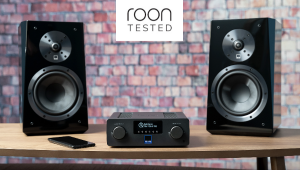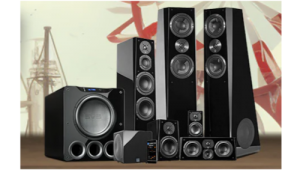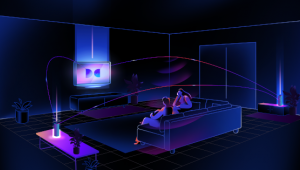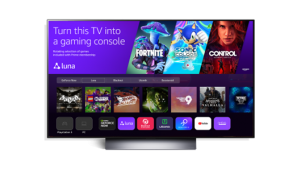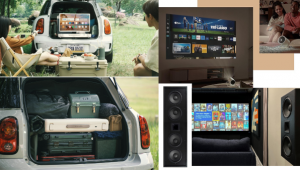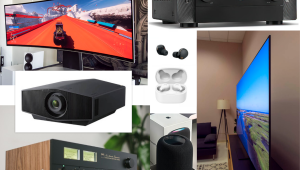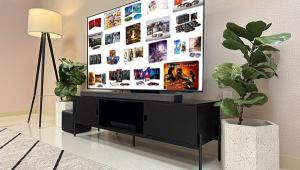HDTV Conference 2005, Day 2
For example, CRT direct view sets still own 40-50% of the worldwide market by revenue. But the fact that they comprise over 80% of unit sales indicates that most CRT sales are of smaller, less-expensive models. Flat-panel displays are predicted to increase from 20% of unit sales in North America today to 67% by 2009. Flat panels in Japan, the biggest market for such displays, should increase to over 90% of TV unit sales by the same year.
Samsung's Jim Sanduski emphasized that HDTV has changed both the sound (5.1 Dolby Digital) and form factor (16:9) of present and future televisions. Historically, 27-inch sets have been the best sellers. (All the screen sizes referenced here are the diagonal measurement.) But it will take a 32-inch, 16:9 set to equal the height of today's 27-inch models. If we assume that screen height is the parameter that most viewers use to judge the size of an image (and there is good reason to suspect that this is the case), the preferred screen sizes will likely increase by at least 20% in a widescreen world.
In 2004, 31.5 million televisions were sold in the US (183 million worldwide). Of these, 7.5 million were DTVs; 85% of these DTVs were HDTV-capable. The top five brands, including Samsung, are all jockeying for market share. In mid August, Samsung announced significant price cuts on many of its displays. Prices on 50-inch PDPs (plasmas) have dropped a whopping 47% in the past year. Flat-panel and other digital-display technologies are hot, and Samsung is bullish on both PDP and LCD. In LCDs, the company's new seventh-generation flat panel designs are expected to go on sale this fall.
But Samsung believes that microdisplays (rear-projection televisions using digital technologies such as DLP, LCD, and LCoS) will survive despite the larger form factors of the cabinets. Unlike flat panels, RPTVs of all types (including CRTs) have a relatively flat cost curve; that is, bigger screens jump in price far slower than other displays as the screen size increases, thus offering better value as they get larger. Samsung—presumably along with other manufacturers—is working hard to develop MD-RPTVs with a depth of no more than 10 inches (as in the sets currently marketed by Thomson-RCA and InFocus).
Samsung is also looking at ways to use LEDs as the light source in MD-RPTVs. LEDs would eliminate the need to periodically replace an expensive UHP projection lamp. They could also eliminate the moving color wheel. Red, green, and blue LEDs could serve the same function by switching on and off rapidly. (This could also potentially improve black levels, but the rainbow effect would likely remain an issue for viewers sensitive to it. Single-chip designs would still require sequential strobing of the red, green, and blue lights.)
Panasonic's Jeff Cove predicted that HDTVs will be in 64% of U.S. households by 2009. The company is a major supporter of PDPs in 37-inch and larger sizes. It currently has two PDP panel factories in Japan, with a third scheduled to begin operations in late 2005. When this third plant is up to full capacity in 2006, all three plants will be able to roll out up to 4.8 million panels per year.
But Panasonic also recognizes that LCD panels are more practical for smaller sets. Together with Hitachi and Toshiba, they are developing a new facility in Japan that will produce up to 2.5 million LCD panels per year (primarily 32 and 37 inches) by mid 2006.
Cove also discussed the resolution limits of the human eye—about 1mm at 10 feet—and how this affects the optimum screen size for a given viewer. With a 480p, 42-inch (diagonal) set, he argued that you can see all the resolution the set has to offer at 12 feet. Move up to 720p, and you need to reduce the distance to eight feet to see it all. And at 1080p, the optimum resolution distance decreases to five feet. In other words, if the average viewer sits farther than eight feet from a 720p, 42-inch picture, he or she won't see all the detail the set has to offer. If you sit much closer than this, you won't see more real detail. But you may see other things more clearly, such as video noise, artifacts, and the set's pixel structure! The corresponding distances for a 65-inch picture were said to be 12 feet for 720p and eight feet for 1080p.
DisplaySearch presented a brief summary of research it had contracted to Westar Display Technologies, Inc. on five different digital displays of various types. The sets chosen for analysis (all of them flat panels and microdisplay RPTVs—no projectors or CRTs) varied in size from 37 to 52 inches.
The study did not appear to factor in the effect of the differing screen sizes. Keeping this limitation in mind, the brightest of the sets tested were a 52-inch MD-RPTV LCoS set from JVC, followed by a 37-inch LG LCD flat panel. The poorest full-screen luminance was from A 42-inch Panasonic PDP, but the same PDP was close to the LCD in highlight luminance (though the JVC was the clear champ in this category as well). Highlight luminance is measured with a portion of the screen full white and the remainder black. Low full-screen luminance but good highlight luminance is characteristic of PDPs in general.
The deepest blacks were from the Panasonic PDP, followed by a Samsung 50-inch DLP MD-RPTV. The poorest black levels were produced by the LCoS and a Sony 50-inch LCD MD-RPTV. The best full-screen contrast was turned-in by the LG LCD, Samsung DLP, and JVC LCoS (all were comparable in this respect. But in highlight contrast, the Panasonic PDP bettered the DLP and LCoS by a factor of at least 2:1—and it beat the LCD displays by nearly 4:1.
Other factors were measured as well—the LG LCD and JVC LCoS produced the best contrast in ambient light, while the JVC and Panasonic PDP had the widest color gamut. All of these results were consistent with what we've found in our viewing and test-bench results over the years at SGHT and
Consumers looking for LCD flat-panel sets should continue to enjoy dramatic, ongoing price reductions. The cost of producing the panels continues to drop, and oversupply will further suppress prices. The response time, black levels, and color consistency of LCD displays is also expected to improve. Sales expectations overall for this year are 50 million panels worldwide, with enough capacity for 160 million by 2006. Available sizes will range from 13 to 65 inches, and more 1080p models in the larger sizes will join the few already on the market.
PDPs are expected to compete with innovations like thin-film screen filters, thinner glass (1.8mm vs. the current 2.8mm), improved gray-scale accuracy, higher resolution (1080p should be available in a 50-inch PDP by next year), and lower power consumption. Chris Kim of Samsung suggested that the lower efficiency of PDPs is a myth; with normal programming (in contrast to a full-screen peak-white test pattern), he argued that they are actually competitive with other flat panel technologies in their power requirements
Paul Meyerhoeffer of Pioneer pointed out a number of common myths that surround PDPs. He suggested that they aren't as susceptible to burn-in as consumers fear, since improvements in phosphors have dramatically reduced this risk. Panel life is also now claimed to be competitive with other displays—most manufacturers are now specifying 60,000 hours to half luminance.
It was an interesting, informative conference. The greatly increased attendance over last year clearly confirmed the fact that HDTV, and the new display technologies developed to display it, are now the driving forces in the television and video market.







